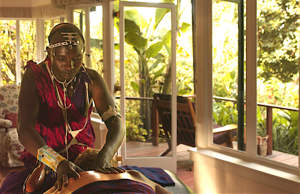The Ecology of Gibb’s Farm







•Recycling - 100% of grey-water from kitchens, bathtubs, rainwater and laundry is recycled into organic farms and gardens via a reed plant filtration system. This system can be viewed in the Vegetable Farm.
•Heating - The largest solar panel array in northern Tanzania has been installed for water heating (photo right). This replaced wood fired water heating systems. Smaller solar arrays are being installed to replace the remaining wood heater boilers that exist away from the new central solar system.
•Sewage - Treatment systems installed for all renovated or new facilities utilize bio-digesting septic tanks and French drain leach fields (45 years ago simple leach pits were the norm up until 2004).

•Irrigation – Non potable water comes from three sources: a 50 year old dam built in the Ngorongoro Conservation Area and piped to the vegetable and flower gardens, reed plant filtered grey water (see recycling above), and well water.

•Fruit and vegetables - The Gibb’s Farm estate supplies 90% of ingredients for our kitchens. 7 acres containing a diverse number of species: 50 vegetables, 13 fruit, and 15 herbs. 100% of these crops are grown organically (without chemicals or pesticides). See List
•Dairy – Between 4 to 8 cows are always providing organic milk, from a herd of about 10 to 20 animals. When not milking the animals are maintained in the estate valley called Namnyak and looked after by the resident Maasai who are a part of the African Living Spa program.
•Meat – Cattle from the Gibb’s Farm dairy herd or employee herds are slaughtered from time to time on the farm. They are fed from feed grown on the farm or nearby villages. 100% of kitchen and food waste are either fed to farm pigs or composted.
•Coffee – 30 acres of coffee are organically cultivated. The beans are cleaned and roasted on the estate.
•Honey – Over 20 hives are dispersed throughout the estate to augment the honey required by Osero Clinic and the kitchens.

Refuse Disposal
Gibb’s Farm practices the “Avoid, Reuse, Recycle, Disposal” hierarchy approach. For example we avoid purchasing beverages in cans and insist on returnable glass bottles. Building materials are reused in foundations or road maintenance. Because of the poor Tanzanian recycle infrastructure, we are self-reliant on recycling such items as plant materials cycled to compost or pig food, pruned coffee tree limbs to cottage fireplace wood. The Farm is totally self-contained; no refuse is exported to the community dump or water systems. Nonferrous metal scrap recycling is the only material we have found a market for and is the only material that leave the Farm’s self-contained system. These efforts are perfected continually with the following categorical results:
•Plastic Water Bottles – Most plastic breaks down in ultraviolet sunshine. After a few months the bottles are broken (walked on actually) and buried in a 80 foot pit, specially designed for non-toxic material. Our plan is to replace commercial bottled water sales and to sell reusable potable water containers with complimentary filtered water refills from the Farm’s well water system.
•Glass Wine Bottles – Bottles are stored in bulk and donated to various causes in the area for recycling. One such project involves a small NGO in Arusha that melts colored glass for jewelry making by handicap artisans.
•Tin and Metal – Tin cans are flattened, burned and placed in the 80 foot pit. Odd bits of metal are reused in construction or sold for scrap.
•Burn and Bury – Miscellaneous items such as light bulbs & metal spray cans (insect spray), are placed directly into the 80 foot pit. The rest is burned and buried.
•Paper and small plastics – Burned and in some cases added to the compost system. In some cases it is placed in the 80 foot pit. Both sides of office paper is used in most cases.
•Motor oil – Spent motor oil collected and used to prevent insect damage to building cladding. We soak the wood in heated motor oil, or simply apply it by brush.
-
• Batteries – The torches (flash lights) used by our security utilize rechargeable batteries and are lit by LED bulbs. We have tested a few for the guest cottages, but find them usually removed without payment. Batteries left by travelers, or otherwise used by the Farm are currently placed in a metal drum with the hope that they will someday be able to be disposed of properly. We try to keep them out of the 80 foot pit.

BUILDING MATERIALS & GROUNDS
All restoration and construction is conducted with minimal importation and local fabrication. Toilet fixtures, most textiles and some electrical materials were imported. This practice develops community skills and minimizes transport fuel pollution.
•Tree Nursery - A tree nursery with hundreds of young tree saplings (predominantly native species) are planted on the farm and in the community and private forest reserve to control erosion and reforest the environment.
•Building Materials - Local materials were predominantly used in all new construction. More than 50% of old building materials were used as foundations, doors, shutters, and roofing for new buildings and restoration. Cottages made of stone and sustainable wood that has been boiled in spent motor oil to protect it from insects to limit brick making and old tree growth cutting.



•Lighting - Skylights - Kitchens and storage areas utilize transparent sheets with the corrugated tin roofing materials to allow natural lighting into the work area. The small photo at right shows both the skylight and the solar heater for the staff lockers.
•Ventilation – Cross ventilation features have been installed in all new construction and restoration. Cottage roof overhang provides shade along with shrub plantings.
•Handicap Access – Most stairs have been removed within the grounds allowing wheel chair and easy access to all facilities. (The main farm house renovation has not yet begun, and when complete will also comply). Guest cottage showers are wide open allowing for easy showering by most people. Select cottages have a long WC room.

LAUNDRY
For years Gibb’s Farm employed a ‘bush laundry’ which required wood fire heated water and charcoal heated irons and the open sun to dry the clothes in good weather. During the raining months a tobacco shed was used. The demands for quick guest laundry cleaning required installation of electric dryers. We have priced guest laundry dried by the sun lower to encourage its use.

•Drying - Sun drying for laundry is used, weather permitting. Inside the laundry building a large open-air translucent shelter allows for some drying even during the raining season.
•Hot Water - Water used to be heated by wood, now it is heated by solar power.
•Detergent - Grey water is recycled (see reed system above), bio-degradable detergent are used.
•Textiles - Many staff uniforms do not require ironing as traditional textiles are used where possible.


•Herb Gardens – A kitchen herb garden comprises over 10 varieties from the Continent. A formal English herb garden examples the tradition of ornamental herbs. (Photo right installing the Herb Garden’s detailed planting patterns.) The Kitchen Herb Garden remains in the Vegetable Garden.
•Cactus Garden – 15 varieties of cactus species have been transplanted to a very dry area of the estate. Much of the building debris has been shifted to this location, if not otherwise used in foundation or road work.
•Flower Garden – Over 210 birds are presently on the Gibb’s Farm bird list. The first seeds of the flower garden was planted over 40 years ago to attract the birds, and to offer a respite of the rigors of safari. Over 260 species are on our sightings list.
•Rose Garden – A small part of the original floral inventory included 15 species of roses. These have been returned to their first location among the oldest cottages and expanded.
•Margaret’s Garden – A small garden under the Library and Kullander House remains in the original design and content. These gardens are enjoyed in the western corner of the estate.
•Medicine Garden – Phyto medicine plants grow near the Osero Forest Clinc in the staff village, Mikahawani. These example those that are non indigenous to our area.
•Trees – Over 30 species are represented on the estate’s private Forest Reserve and gardens.
•Shrubs – Over 30 species are represented on the Farm estate.
•Ornamental Flowers – Nearly 200 species are represented on the Farm estate. An exhaustive list is currently being completed.
Environmental Preservation

To create Gibb’s Farm as the destination where the facilities and services are internationally recognized by world media and global travel authorities. Gibb’s Farm shall surpass all guest expectations and international standards established by a forever-evolving and competitive industry by maintaining its originality with revolutionary concepts that inspire the human spirit. The resident guest’s life is enhanced while the community of nature and indigenous cultures touched by Gibb’s Farm is improved and sustained.
Community and individual wellbeing is attained through personal provisions and life-learning. The oldest coffee dairy farm in the Ngorongoro Forest, Gibb’s Farm is the world traveler’s respite from the rigors of life’s safari. Here, one discovers a community of nature, people, culture, art and beauty providing a sense of place and history.
To achieve these important goals we shall all follow the spirit of NiMTUSiJuHa: Ndoto Shared Vision/Idea, Mwe l ekeo Attitude, Tumaini Anticipation, Umi l ikaj i Ownership, Si fa Top Quality, Jukumu Responsibility, Ha Tua Initiative.
Kama shamba la zamani la kahawa na mifugo ndani ya misitu ya ngorongoro, Gibb’s Farm ni mahali wageni kutoka pande zote za dunia wanapata nafasi ya kupumua kutokana na ugumu wa safari ya maisha. Hapa mmoja anavumbua mimea na wanyama, watu na utamadauni inaotoa hisia ya historia, mahali na kuwa na uhusiano wa kijamaa. Gibb’s Farm itazidi mategemeo ya wageni na viwango vya kimataifa ambavyo vimewekwa na ushindani inayobadilika kila mara kwa kutunza asili yake na kutekeleza mabadiliko inayoguza roho za watu.
Siyo kwamba maisha ya mgeni pekee ndiyo itaendelezwa, wanyama na mimea, utamaduni na watu wakakaoguswa na Gibb’s Farm watadumishwa na kuendelezwa Kupitia uimarishaji wa matakwa binafsi na utekelesaji wa elimu kwa manufaa ya wote. Kwa kufahamu haya na juhudi zilizo pangwa, Gibb’s Farm haitakuwa tu mahali ambapo vifaa na huduma zinatambuliwa na mamlaka za kimataifa bali itaongelewa kwenye viombo vya habari vya kimataifa.
Kwa kufanikisha haya yote muhimu, lazima tufuate moyo wa NiMTUSiJuHa. Tunashukuru wale wote walioshiriki kwa kutoa michango ya mawazo wa kutoa kielelezo hiki cha neno la ndoto.

Vision Statement


Notes:
1 Ecotourism Society Newsletter, Spring (1991).
2 Martha Honey, “Ecotourism and Sustainable Development, Who Owns Paradise?” Island Press (1999), pg. 25.
3 Welcome to the Experience Economy, B. Joseph, II Pine, James Gilmore, Harvard Business Review (July 1998)
New Tourism & the Harmony Project, All rights reserved.
Copyright © 2004 - 2012
African Living Spa, and Living Spa ® are registered/trademarked.
Environmental Awards

The Power of Travel,
26 World Savers who Move the Earth
In the recent Condé Nast Traveler magazine, Gibb’s Farm ranked 5th in the ‘doing it all’ category of the World Saver 2009 Award.
Judges looked at five types of initiatives: education, poverty alleviation, wildlife conservation, cultural and environmental preservation, and health. They chose winners and runners-up in each category, and recognized companies that had achievements in all initiatives called ‘doing it all’. (click below)




ECOLOGY OF GIBB’S FARM AS A MODEL FOR EAST AFRICA
RESPONSIBLE AND SUSTAINED DESTINATION MANAGEMENT
Margaret and Jim Gibb concerned themselves with the ecological responsibility of the farm soon after they started to manage it in 1948. Concerned not only as stewards of over 500 acres of land at the time, but for the community and wildlife as well.

Margaret tells the story of her efforts to assist with community health in the early 1950’s, sharing simple home remedies with villagers asking for help. Today the Osero Forest staff clinic may be considered as a logical extension of her early sense of responsibility.
Our model to the region as a global example of responsible and sustainable operation is based on decades of evolving effort. Today eight floral gardens attract over 250 bird species, seven acres of organic vegetables utilize compost from the kitchens, dairy and pig farms to feed the travelers and staff were all started by the Gibbs.
Although they retired around seven years ago, the vision statement at right reflects the far reaching model we continue to hone.
In 1991 The International Ecotourism Society (TIES) defined the new trend as “responsible travel to natural areas, conservation of the environment, improvements to the well-being of local people”. (note 1) It was expanded in 1999 by Martha Honey to “responsible travel to natural destinations with minimal impact and environmental awareness building; direct financial benefit to conservation efforts and the local community; support of local culture, human rights and democratic movements”. (note 2)
This updated definition, however, is still limited to the consequence of eco-travel and does not engage the ulterior motives for “experience” or purpose for travel other than awareness/education. B. Joseph Pine II & James H Gilmore approaches the purpose for travel with these definitions in 1998 – in the Experience Economy. It describes the economic progression from Manufacture and Service Economy to the Experience Economy. “An experience is not an amorphous construct; it is as real an offering as any service, good, or commodity. (note 3)
The evolving responsible tourism definitions appear to be finally catching up with the real practices of Gibb’s Farm. As accomplishments are tallied over the decades our goals are revised to reflect a more refined, consistent and clear approach for others to model. The Vision Statement at right was created over a year’s time in 2005 with many in the Gibb’s Farm community.
We set out to pursue something entirely different. It's a strategy that sees today's innovations as the first steps in a transition from the maintenance of an ageing tourist-based system to the creation of a new one. Rather than simply limiting economic growth or reducing our impact, we celebrate the legacy of the historic farm’s foundation which both self regulates and creates positive effects for a large and beneficial ecological footprint: sustaining rather than sustainable.

In this Ecology of Gibb’s Farm website we address six areas noted above. In other links we offer more information of the developed services of community health, art and beauty. Gibb’s Farm has chosen to assess its 40 year sustainability efforts in practical terms, as viewed in context with the contemporary thesis Cradle to Cradle, by McDonaugh and Braugart.





The Green Living Project’s 2008 video introduces some of the ecological practices of Gibb’s Farm. Click on the logo to view their mention of the farm. Click on the video above to view the documentary.

Gibb’s Farm Selected
First Place Honoree 2010
Responsible Tourism Showcase U.S.Educational Travel Community
The Educational Travel Community’s recognition of our Living-Museum educational programs, bridging the traveler’s experience, community learning and economy, is based on the long heritage of this eighty year old farm estate.



Tanzania Tourist Board to award
Gibb’s Farm Hotel/ Lodge/ Camp Sustainable Tourism Award for 2011

-
Other Gibb’s Farm web-links:






